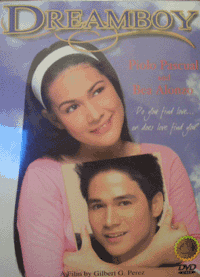“Dreamboy” is a commercial treat targeting those who want to get a pinch of love from a feel-good romantic tale. It talks about a game of chances in love with so much risk at stake.
The story springs up from the fact that TV networks are going gaga over reality shows’ newfound potential for better TV ratings.
Utilizing that usual girl-meets-boy premise, the major plotpoints kick off with the romantic meet-ups between the clueless spectator Cyd (Bea Alonzo) and the ideal guys Phillip, Eboy, and Jaime (Piolo Pascual). The movie’s massive publicity and promotion make it a point not to dwell much with this romantic comedy’s narrative structure so as not to break the suspense for people watching it on the big screen.
“Dreamboy” plunges into the domain of the salesgirl Cyd, an ultimate fanatic of romance novels. She is in constant search for her “dreamboy,” her soulmate, as how her pocketbooks suggest. Soon, she meets Phillip, the son of the owner of the supermart where she works. In the next few days, their encounter leads to a whirlwind romance. However, it turns out that their fairy tale romance readily needs to end as complications between their economic differences confront them.
While still mending a broken heart, Cyd meets the adventurous, athletic, and “kanto boy-type” Eboy. Cyd sees uncanny resemblance between Phillip and Eboy. Eboy’s rugged personality as a guy who says and acts what he wants without much thinking takes over a new space in Cyd’s heart. As they go through several thrilling adventures together, Cyd falls for the rough guy. But just when she is ready to submit to her feelings for him, she feels betrayed upon learning about her new man’s past escapades with other women.
While trying to get over both Phillip and Eboy, Jaime pops into Cyd’s birthday bash. Though she sees some similarities and a few doubts among the three guys, she keeps her thoughts to herself. As Cyd and Jaime spend more time with each other in Jaime’s rural hometown, their love starts blossoming in par with nature’s wonders. From here, the story gets clearer as it continues to unveil the reality TV show behind the poor victim Cyd. It turns out that Cyd’s search for her dreamboy is actually a molded scenario for a TV station’s reality search.
The script dwells into the emotions presented in life’s harsh realities. The narrative talks about the dream of finding true love and the sincerity that pushes this forward. It starts with a rather ordinary romantic storyline, dialogue, and treatment, but it ends in a not entirely predictable way. It shows the interesting facets of Cyd’s dreamy, romantic character coming to life as his dreamboy of the moment creates a colorful world for the two of them — each time.
This rom-com offering’s production design compliments its glossy cinematography, which is, as expected, in line with the traditionally glossy Star Cinema look. Pinks and yellows work as highlights in the many scenes’ bright and pastel combinations. With focus on the hopeless romantic audience, the dreamy, fairy tale moments set in picturesque locations promote a feel-good effect. Everything seems crafted for mass consumption.
However, the production design lacks research and consistency. The screen is always filled with saturated elements and fillers including paintings, “kikay things,” frames, cloths, and furniture. There is no much room for vacant spaces. Overtly done to make the set a seemingly designed structure in favor of the camera, the scenes exude a contrived and somewhat fake-looking sense of space. Worse, some shocking props shown inside the room of the girly and romance-stricken Cyd are just horrible. An establishing shot of Cyd’s room before showing her on frame reveals a cloth or a sort of painting of Che Guevarra, plus another clearly similar shot showing a print with the appalling combination of words like “I am a Hippie.” Generally, there is nothing wrong with such elements — except if they clearly don’t coincide with the character’s established personality. In the case of Cyd’s characterization, there is no sign of a hippie Cyd. In fact, there is no single suggestion of her being a punk or a non-conformist type of lady.
It’s as if all these elements are simply utilized as mere props either because the production people personally like them or they think the colors or shapes of these props can simply fill the vacant spaces on frame — without any concern on more responsible and effective storytelling.
Throughout, the picture remains mostly cut to cut from one scene to the next. Many shots promote mass appeal. Camerawork is typical for a motion picture meant to push the button for the viewers’ love story-escapism mode. The tight shots typically utilize slow-motion effects to add that generic romantic flair.
With the current mass appeal of the “teleserye” princess Bea Alonzo and the quintessential heartthrob Piolo Pascual, they deliver a considerably fine charisma and rapport as a screen pair.
Though Cyd is a hopeless romantic, she is a smart girl and a fighter who knows how to play the game even while in the midst of emotional conflict. She exudes the modern and “non-pakipot” type of female character in this tale. She is not a shallow character capsulized with that traditional Maria Clara stance or passive Cinderella persona. She doesn’t yield to the fall upon learning that she is a victim of a reality TV show.
The characters Phillip, Eboy, and Jaime become effective stimuli to unveil the hibernating colors in Cyd’s life. The depth of these characters helps push the story forward.
The voiceovers are not very catchy at first. But as the tale progresses, they become justifiable. However, some plot mechanics raise questions left unanswered in a satisfying manner by the movie’s end.
Sponsors, tie-ups, and ex-deals are very much apparent in the movie. More often than not, the product shots of hair and grocery products, brands of clothes, among others get too much attention on screen. Not bad if subtly, strategically, and creatively done, but the production usually goes way overboard that the said elements already feel like serious storytelling distractions.
This motion picture can work like an experiment for its producer — whether such premise for a reality show could actually be done and how the masses would probably take it.







